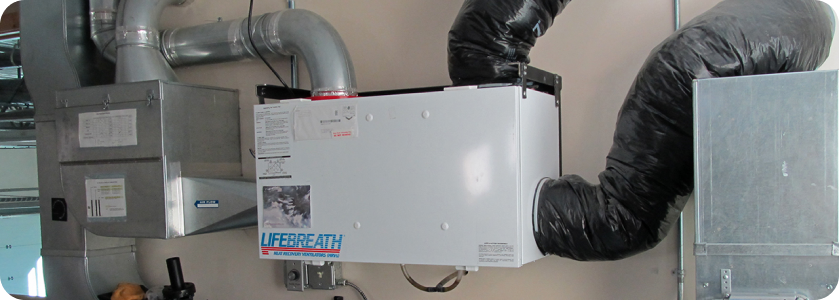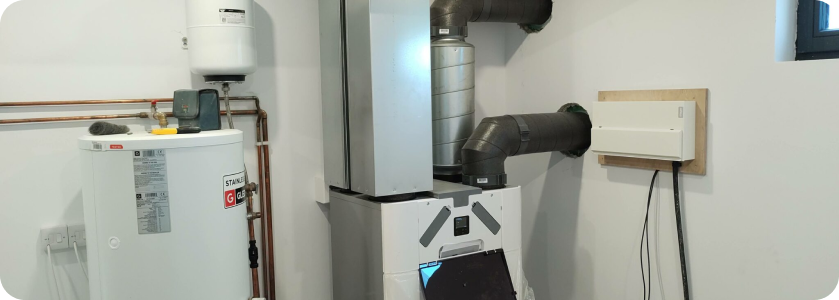Heat Recovery Ventilator (HRV) Cost
Nowadays, building a conducive home requires a high level of ventilation. If you have a new home, you would most likely need to equip it with an air exchange system. This is important, as an air system such as the HRV system helps maintain indoor air quality and allows fresh air to flow into your house.
You might need to install a heat exchange system in your home for several reasons. However, before making such decisions, it is best to understand how HRV works, the benefits, and the required cost.
What is a Heat Recovery Ventilator (HRV)?
A heat recovery ventilator is a heat exchanger system that reduces high humidity and exhausts air in a room by replacing stale air with fresh air. It provides better indoor air quality and improves fresh air circulation all year round.
An HRV helps to manage the exhaust air around the home while also functioning as a heating system. HRVs usually have two fans and an in-built air-to-air heat exchanger, ensuring a seamless air exchange between the exhaust and cold air supply.

Benefits of a Heat Recovery Ventilation System For Indoor Air Quality
Heat recovery ventilators work by exchanging the heat from the outgoing stale air with the incoming fresh air, thus reducing the load on your heating and cooling systems. Here are a few benefits of HRVs.
- Improved indoor air quality
- Regulate humidity levels
- Prevents mold growth and condensation
- Cost savings
- Optimizes the temperature of your home without the use of an air conditioner (AC)

Breaking down the cost of an HRV System: Purchase, Installation and Operational Costs
HRV heating systems are designed to improve air circulation while conserving energy by recovering heat lost during ventilation. The installation of an HRV system requires professional skills.
A ductwork system is usually designed and installed to ensure indoor air flow throughout the building. The HRV unit must be installed correctly in an insulated area to prevent interference with the duct units.
Purchase Costs
The recuperation cost of HRVs usually varies widely depending on various factors. On average, acquiring a basic set of HRV alongside other consumables can cost between $1000 to $1500.
Intermediate or middle-class systems can cost between $1500 to $1800, while the premium sets can range between $2000 to $2200.
How to Reduce the System Purchase Cost
Some of the effective ways of reducing system purchase costs include;
- Carefully assess your property’s size and heating/cooling needs before purchasing an HRV system
- It is best to proceed with the process with a professional.
- Accurate gauging of the requirements of your space can help you avoid investing in an oversized or undersized system, which could end up costing more in the long run.
- Going for a quality set will also save you from recurring recuperation and repair costs.
Installation Costs
The installation cost also varies depending on the type of HRV system, installation complexities, and work volume. The installation cost can range from $1250 to $2000 on average. This cost includes the installer’s salary and other logistics for smooth installation.
Operation Costs and Energy Consumption
The operational costs of HRVs are mainly on energy and scheduled maintenance, which is not very often. The power of an HRV rarely exceeds 50 to 100 watts, making it more energy efficient than most HVAC systems

Long-Term Savings and Efficiency
HRVs can be costly to purchase and install, but they can be more cost-effective. However, it pays off in the long run through reduced energy bills and improved indoor air quality.
HRV systems provide benefits like long-term energy savings and efficiency to building owners. An HRV unit can reduce the energy needed to cool a building by reusing heat and exhaust air. This can lead to substantial savings on energy bills in the long run.

Factors That Affect the Price of an HRV
The price of HRV systems can vary depending on several factors. Depending on individual needs, these factors are responsible for varying prices around different locations.
These factors include;
Current Air Ducts
Current air ducts can significantly impact the price of a heat recovery ventilation (HRV) system. If the air ducts are old, damaged, or clogged with debris, it can restrict airflow and reduce the effectiveness of the HRV ducts.
Size and number of rooms
Knowing the number of rooms in which a heat exchanger can supply fresh air is essential. HRV systems size is determined by the square foot or cubic feet measurements of the building it will serve.
It is crucial to select an HRV system that is appropriately sized for the building to ensure that it can supply fresh air to all rooms.
Size and Quality of HRV System
The size and quality of the HRV system are also essential factors influencing the price of installing an HRV system. The bigger the size and the better the quality of the HRV system, the more expensive it is, and vice versa.
Other Factors
Other notable Factors that can significantly affect the cost of an HRV include;
Amount of required labor and consumables
The system’s energy efficiency
Design
Type of space (Private or Commercial)
Heat Source

HRV vs ERV: Selecting the Ideal Home Ventilation System
When considering which ventilation system to install in your home, evaluating your needs and climate conditions is essential. A heat recovery ventilator (HRV) may be more suitable for living in a region with extreme temperature variations.
However, if you reside in a hot and humid climate, an energy recovery ventilator may be more beneficial as it can help maintain proper humidity levels in your home.

Let's Talk HRV Options Today
In today’s world, reducing environmental impact and energy consumption is a top priority for many homeowners. One effective way to achieve this goal is by the use of HRVs. If you require an HRV system, contact our team, and let’s provide expert guidance on which HRV to choose and help with your installation process.


